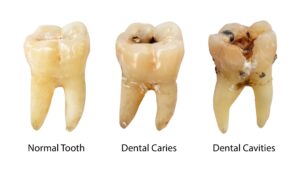How Do You Know If You Need a Dental Filling?
October 13, 2023
 Your teeth are protected by the hardest substance in your body. Your enamel is the outer layer of a tooth that protects the underlying dentin and pulp. It’s stronger than some metals, but it isn’t any match for cavity-causing bacteria. An acidic plaque created by sugars and starches can erode your enamel until a cavity forms, which will require a filling to treat. How do you know if you need a filling? Here’s how to spot the signs of tooth decay.
Your teeth are protected by the hardest substance in your body. Your enamel is the outer layer of a tooth that protects the underlying dentin and pulp. It’s stronger than some metals, but it isn’t any match for cavity-causing bacteria. An acidic plaque created by sugars and starches can erode your enamel until a cavity forms, which will require a filling to treat. How do you know if you need a filling? Here’s how to spot the signs of tooth decay.
Common Symptoms of Tooth Decay
Although cavities can be prevented, 92% of adults have experienced decay. Your dentist can spot early signs of enamel loss during routine dental checkups, allowing them to treat the issue before it turns into a big problem. With no treatment, decay can reach the inner layers of a tooth, which can increase your risk of an infection that will require a root canal to treat.
You can avoid the complications of severe decay by getting treatment at the first sign of a cavity, which may include:
- Tooth Pain: A cavity can cause a tooth to ache or throb. You may have a sudden jolt of pain when biting down on hard or cold foods.
- Sensitivity: Cavities can cause tooth sensitivity because the barrier between your dentin and pulp is weakened. You can experience sensitivity to hot, cold, acidic, and spicy foods or drinks. Inhaling cold air can also cause a sudden twinge of pain.
- Dark Spot or Hole: As a cavity progresses, a dark spot or hole may appear. You may even feel it when running your tongue over your tooth.
- Damaged Filling: If your cavity has been treated previously with a filling, it will need to be replaced, eventually. If your filling is older or falls out, it may be time for a replacement.
Benefit from Tooth-Colored Fillings
Your dentist will examine your mouth and may review an X-ray to determine if you need a filling. The process of treating your tooth is quick and painless. Your dentist may administer a local numbing agent to prevent any discomfort while decay is removed using special dental instruments. Your tooth will be rinsed and dried before placing a weak acid on it to open the pores in your enamel. Your dentist will use a composite resin material to fill your tooth, which will be shaded to match the color of your enamel to blend in. After the material is molded, your dentist will use a special dental light to harden it in a matter of seconds.
Fillings can last for 10 years or more to benefit from long-term protection. If you have symptoms of decay, don’t wait to contact your dentist.
About Dr. Luciano Marini
Dr. Marini earned his dental degree from the University of Connecticut School of Dental Medicine and has regularly continued his education in all aspects of dentistry, including preventive services. He is a member of many professional organizations, including the American Dental Association. Request an appointment through his website or call (203) 575-9097.
No Comments
No comments yet.
RSS feed for comments on this post.
Sorry, the comment form is closed at this time.



